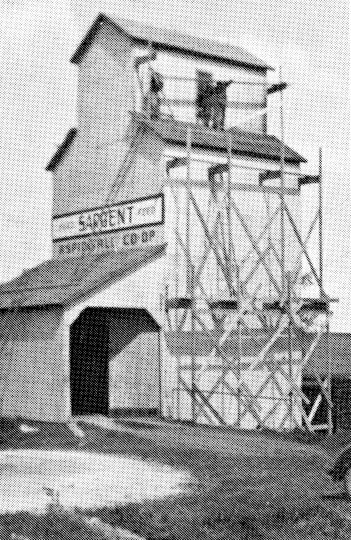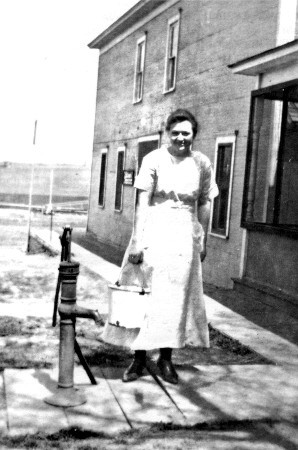
The Aspinwall Cooperative was officially organized April 1, 1944 "to deal in lumber, coal, hardware, feeds, seeds, etc., so farmers might have a convenient place to buy goods that they need and purchase said goods at a competitive price, and share in the profits of the business." The first annual report, given February 28, 1945, showed that the Co-op had 155 members and sales of $42,717.
In the earlier years, the elevator did little or no feed business; raw materials used in feeds, such as block salt, was sold at the grocery store. One of the biggest parts of the business was the sale of coal; 20 to 22 train car loads would arrive each fall and never be put into the coal bins, but went directly to the farms and homes for fuel.
Ray Smith was appointed as manager in 1945, and directors were president Hubert Lamp, vice-president W.J. Kruse, secretary Emil Ehlers, and C.H. Jahn, Alfred Ehrichs, William Hansen and Leonard Holdsworth. After Hansen's death, Clarence Bowers was appointed. Smith resigned in 1949, and Charles Greenlee was named manager in January, 1950. At the time, sales were $90,000.
February 1, 1952, the Co-op purchased Wilmer Ehrichs' tankwagon and business, and the Co-op thus entered the petroleum business. Later that year, Roy Hofsommer was hired to replace Greenlee, and the Co-op's other employee was Carl "Kelly" Musfeldt.
Sales had risen to $288,000 by 1954. A petroleum bulk plant was purchased in Manning and Roy Schilling was added to the work force. Also in 1954, a government storage bin, 40 by 100 feet, was erected, and another 40 by 120 foot bin erected in 1955. Both bins still exist and are used today; at the time, they gave the Co-op a total storage capacity of 100,000 bushels.
Robert Schilling was hired to replace Roy Hofsommer as manager in September, 1956.
A concrete block building measuring 40 by 120 feet was built in 1958 to serve as the Coop's new office building and bag feed storage area. A 10 by 50 foot scale was also installed to the north of the office, which are located on Aspinwall's Main Street.
A branch store in Gray was opened in 1959; it continued for several years and then closed. Also in 1959, the existing wood elevator was remodeled and mill machinery was installed there.
The lumber business was discontinued in 1960, and the inventory was sold to Rasmussen Lumber Company. The building was auctioned and buyer Carl Musfeldt tore it down.
Robert Schilling resigned in February, 1963, and Larry Hand became manager; Hand resigned in December, 1964, and Keith Clifford took over the job.
The first corn dryer was installed by the Coop in 1967; a 10,000 bushel wet tank was built at the same time. This set-up is located directly across the street from the office.
Herman Gerdes became manager in February, 1968, and Merton Ross was hired as manager two years later when Gerdes resigned. The Co-op went for several years without any major expansion projects; in 1975, two 40,000 bushel grain bins, a grain leg and dryer were built.
Custom application also started in 1975 with a sprayer mounted on a pick-up. The high clearance sprayer was purchased in 1976, and in 1977 the Co-op went into the fertilizer business. This consisted of adding a building for the storage of fertilizer, and which could also house the fertilizer suspension machine that converted dry


Continued from page 59
Large grain bins, located on the corner formerly the site of the Opera House, are part of the Aspinwall Co-op today.
NOTE the picture on
this page is a duplicate of the picture on page 61. It is not known who submitted the
picture or what it looked like that belonged with this caption.
fertilizer into liquid fertilizer. At the time, it was one of the few machines of that type in the entire state of Iowa. A "Big A" flotation sprayer was also purchased at this time.
As of 1982, the Co-op has two of these Big A sprayers and the fertilizer building was expanded to hold 900 tons of dry fertilizer and 300 tons of liquid fertilizer. There is also now an 80,000 bushel grain bin which was added in 1980, and a 160,000 bushel grain bin which was built in 1981. This gives the Co-op a total grain capacity of 455,000 bushels; total yearly sales are expected to exceed $4,500,000 this year.
Randy Behrens was named manager in February, 1979, when Merton Ross retired. Randy began working for the Aspinwall Co-op in September, 1969. Other current employees and when they were hired are: Allen Ehlers, assistant manager, January, 1977; Ronald Schilling since May, 1975; Dean Hupp since December, 1972; Gary Vinke since April, 1979; Jeff Joens since December, 1979; Cindy Hinners since November, 1979; and Karla Francois since September, 1974.
The board of directors now includes president Dennis Backhaus, Vice-president Art Fielweber, secretary Lowell Schroeder, Wayne Ranniger, Chris Brandt, Alan Lorenzen and Wesley Nulle.

Page 61
ASPINWALL STOCKYARDS
The Aspinwall stockyards were built and owned by the Milwaukee Railroad
Company at the time the town was established in 1882. The holding pens and
loading chutes were built for the purpose of holding cattle, hogs, and other
livestock while awaiting shipment to other areas of the country. In the early
days, shipments were made entirely by rail, but trucks began taking over and
eventually replaced rail shipment entirely.
The railroad hired men to maintain the condition of the pens and yards, but the watering and feeding of the animals and other caretaking jobs were the responsibility of the managers. The managers, in turn, would hire local men and youth to perform these duties. As the yards were owned by the railroad, anyone could ship stock directly as well as going through one of these manager-buyers.
The Dutt Brothers, Tom and E.R., were probably the first men to become buyers at the Aspinwall stockyards. We have reference to them buying and shipping hogs and cattle as early as 1884.
Jacob Carstens and W. Thomas Ralph bought and sold livestock in the early 1900s. Ralph, who also taught at the Aspinwall School, lived with Jacob and Minnie Carstens before his marriage. He shipped mostly hogs to Chicago, and he covered a large territory which included Carroll. Stock bought in that area was shipped from stockyards there.
Elva Ralph Arndt, his daughter, was born in Aspinwall and spent her early years here. "I remember seeing the loading pens when I was real small," she wrote from her Bellevue, Nebraska home. "Also when I was small, I remember seeing cows in people's back yards for milk, cream and butter; people also fattened hogs to butcher, and almost everyone had a few chickens."
The Ralph family moved in about 1910, but Carstens continued buying and selling livestock. Others who operated the stockyards have been Louie Koester, Bill Wegner and Frank Ehrichs.
William (Bill) Wegner was a big cattle and hog operator around the Aspinwall area for a long time. He lived on a farm west and south of town, now owned by the Vennink family. Bill managed the Aspinwall stockyards for quite some time and conducted a large business operation through the yards. Bill hired Henry Kruetzfeldt as his caretaker.
In a 1927 edition of the Manning Monitor, we found that in a single week, Bill shipped three carloads of hogs to Cambridge, Massachusetts, five carloads of hogs to Cedar Rapids, and two carloads of cattle to Omaha.
Aspinwall had at one time a major event called "Hog Day." This was a day set aside for the shipment of hogs only. When this day arrived it was utter chaos in town! There was never enough room to hold all the hogs in the yards, so the vacant lots, pastures and extra spaces in the town were packed with the squealing critters! Some people remember seeing hogs packed tight in the small area behind the saloon! After unloading the teams, sleighs and wagons lined Main Street as owners went for refreshments.

Page 62
Most of the people we have talked to remember Frank Ehrichs as the manager of the Aspinwall stockyards, probably because he held the job the longest and was the last to run the yards.
Frank would hire men from town to take care of stock that he was feeding himself, plus the other animals that were in the yards. Robert and Alvin Schilling both worked in the stockyards, and Bill Soll was a long-time employee of Frank's.
Many people would sell their hogs and then go to the store, which Frank also operated, to pick up their checks. Frank would pay them, and as Reuben Stoberl remembers, he would hand out a bag of fresh fruit -- full of the biggest oranges you ever saw, apples and bananas -- with the comment, "Bring them home to your family."
The stockyards included six standard size pens, plus one large pen at the rear where the cattle were fed. Water had to be pumped by hand for the stock. The cattle, hogs and sheep were weighed by a state-inspected scale, and could be loaded onto railcars through the rail chute or onto trucks through a truck chute. The livestock -- more hogs than cattle -- was railed to Omaha, Sioux City, Chicago, Des Moines, Perry, Storm Lake, and even as far as California or the east coast. The rest was sent out by trucks, with as many as four straight trucks hauling out loads in a day during the 1950s.
The territory extended east of Manning to Manilla, with livestock hauled in from a 10-mile radius of Aspinwall. In the earlier days, the livestock was either driven in or hauled in wagons or sleighs pulled by horses; later the stock would arrive by pick-up or truck.
Toward the end of Frank's career he sold hogs only, and by this time most of the stock was shipped by trucks.
When the stockyards finally closed after Frank retired, the Co-op needed room to build a fertilizer shed. In about 1960, the stockyards were torn down and the once busy and prosperous area of town was no more.
ODDS AND ENDS
Livestock shippers out of Aspinwall during the past week were William
Wegner, three cars of hogs to East Cambridge, Massachusetts, five cars of hogs
to Cedar Rapids, Iowa, and two cars of cattle to South Omaha; J.C. Thiedeman,
one car of cattle to South Omaha; William Hass, one car of cattle to South
Omaha; Julius Guth (Note in the book it was printed as Julius Gute), two double deck cars of sheep to South Omaha;
George Zimmer, one car of cattle to South Omaha.
Manning Monitor, January 6, 1927

